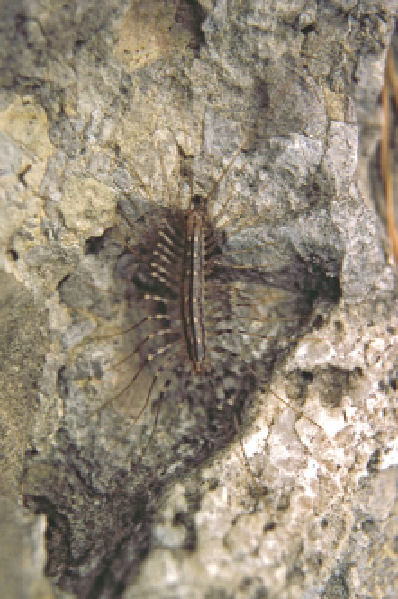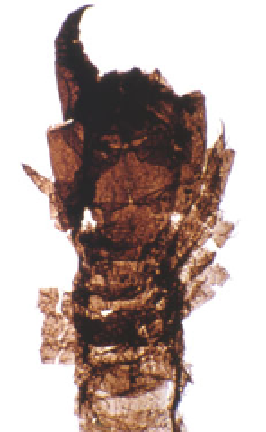Geoscience Reference
In-Depth Information
Devonian ones were tiny, no more than 7-8
mm (0.3 in) long. Middle-sized
eoarthropleurids, about 15 cm (6 in) in
length, occur in late Silurian beds in
England and Devonian rocks in Germany
and North America (Størmer, 1976; Shear
and Selden, 1995; Shear
et al
., 1996).
Eoarthropleurids resemble large, flat-
backed millipedes, but fully articulated
specimens had never been found, and
nothing was known of their heads or how
many segments may have been in the trunk
until the tiny forms, belonging to the order
Microdecemplicida, were found at Brown
Mountain and South Mountain. These
animals were probably less than 5 mm (0.2
in) long, and had 8 trunk segments each
with two pairs of legs, a collum behind the
head, a complex mouthpart system (
102
)
and an anal cone (Wilson and Shear,
2000). It is likely that they were detritivores
like other millipedes.
Centipedes
In contrast to millipedes, centipedes are
fast-moving terrestrial predators with
relatively longer legs and poison claws.
Specimens belonging to the order
Scutigeromorpha, to which the common
house centipede
Scutigera
(
102
) belongs,
have been found in rocks as old as Silurian
from England (Jeram
et al
., 1990), as well
as from the Lower Devonian Rhynie Chert
of Scotland (Anderson and Trewin, 2003)
and the Middle Devonian Brown Mountain
(Shear
et al
., 1998). Another swift
centipede from Gilboa is
Devonobius delta
(
103
), described by Shear and Bonamo
103
102
103 Front part of the centipede
Devonobiusdelta, showing one of the
paired poison claws on the left AMNH.
Length 1.5 mm 0.06 in.
102 The modern house centipede Scutigera
coleoptrata; seen here in its original habitat
under a rock in the Mediterranean, it is now
widespread around the world in warm
climates. Body about 20 mm 0.8 in long.





Search WWH ::

Custom Search